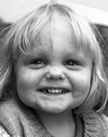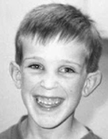FACIAL FEATURES AND DYSMORPHOLOGY
Diagnosing Genetic Disease Based On
Asymmetric and Abnormal Facial Features
by Joelle Steele
 I am an anthropometrist specializing in the analysis and comparison of facial features for the purpose of confirming or authenticating identities of people in photographs. When you look at photographs of people every day like I do, especially family photos, you see an extremely wide variety of facial traits. Some of those traits, ones that are less common to the average person, could signify a rare genetic disease. Today, those diseases are being diagnosed with the use of software designed by British physician Dr. Peter Hammond. But the use of facial features to diagnose disease dates back to the Victorian era and the work of a man named Francis Galton.
I am an anthropometrist specializing in the analysis and comparison of facial features for the purpose of confirming or authenticating identities of people in photographs. When you look at photographs of people every day like I do, especially family photos, you see an extremely wide variety of facial traits. Some of those traits, ones that are less common to the average person, could signify a rare genetic disease. Today, those diseases are being diagnosed with the use of software designed by British physician Dr. Peter Hammond. But the use of facial features to diagnose disease dates back to the Victorian era and the work of a man named Francis Galton.
GALTON AND EUGENICS
Today, we know of Galton because he classified fingerprints into distinct patterns and made them admissible as evidence in court. He is also the person who originally coined the phrase "nature versus nurture." But Galton is also known for coining another term: eugenics. This controversial science theorized that the human race could be improved by selective breeding that would increase the incidence of desirable characteristics in people. Galton devoted much of his later life to studying human variations (including those of twins) and facial features, and to collecting data to provide evidence of genetic inheritance. He thought that his techniques would be useful in identifying criminals by facial features types and in making medical diagnoses. He eventually abandoned those theories as unworkable and impractical.
HAMMOND'S PROGRAM
But Galton may have been on the right track when it comes to medical diagnoses, at least according to the work of Dr. Hammond. Hammond created a computer program to diagnose 700 facially-characteristic genetic disorders (out of an estimated 6,000 or more genetic diseases and disorders) and then spent seven years traveling all over the world collecting multiple photos of people with genetic disorders, creating 3-D images of them, and then entering the images into his database. The program analyzes facial traits of patients and compares them to those of people in his database. So far, Hammond's program is purported to be 90 percent accurate in diagnosing these often rare genetic diseases.
DYSMORPHOLOGY
The study of asymmetrical or abnormal facial features is called dysmorphology (from the prefix "dys" meaning abnormal or impaired, and "morphology" meaning form or structure), and it is based on the establishment of certain average or "normal" physical traits – something that is certainly hard to establish since there is no single "perfect" face in the world. Dysmorphology harkens back to Galton's eugenics studies in that regard, but there are simply some traits and combinations of traits that are very uncommon in any face, and so those variations are used by Hammond to isolate diseases and disorders. If a disease is characterized by a certain combination of variations, such as an upturned nose, eyes overly close together, and an excessive overbite, then physicians can use this information to run only those tests that would accurately diagnose whatever illness is characterized by those three traits appearing together on a face. This could be a key to early and less costly diagnoses of these diseases, many of which are obscure and are accompanied by other less visible but serious conditions, such as kidney or heart problems that require immediate treatment.
FACIALLY-CHARACTERISTIC DISEASES
Almost any layperson can recognize Down syndrome when they see it, but try to remember all of the combinations of facial characteristics for each of those 700 facially-characteristic diseases? It would be impossible. Here are just a very few examples of facial trait combinations found in some rare disease syndromes:
Ablepharon Macrostomia: lack of or underdeveloped eyelids; absence of eyelashes and eyebrows, wide fish-like mouth, incompletely developed low-set ears
Alagille: broad, prominent forehead, deep-set eyes, small, pointed chin
Autism: wider eyes, broader upper face, shorter middle region of face, and wider mouth and philtrum
Fragile X: large head, long face, prominent chin, ears, and forehead
Langer-Giedion: pear-shaped nose, bulbous nose, small jaw, thin upper lip, large ears, head smaller than normal
Mowat-Wilson: square-shaped face, deep-set eyes, widely spaced eyes, broad nasal bridge, bulbous nasal tip, prominent and pointed chin, large flaring eyebrows, uplifted and dimpled earlobes; with age the face elongates, brows are bushier, and chin and jaw are more pronounced







ABOVE: Facial features of children with (top to bottom, left to right) Alagille, Fragile X, Williams, Aperts, Autism, Crouzon, and Rubenstein syndromes.
Noonan: droopy upper eyelids (ptosis), eyes widely spaced, eyes tilted downward at outer corners; flat nose bridge, broad nose, small lower jaw, ears set lower on head
Pallister-Killian: high forehead, sparse scalp hair, very wide set eyes, fold of skin over inner corner of eyes (epicanthus), and broad nasal bridge
Smith Magenis: flat mid-section of forehead and nose bridge; turned-down mouth, prominent cheeks, broad and square-shaped face, prominent jaw, deep set eyes, slight "uni-brow," flat/wide/disproportioned head
Williams: broad forehead, fullness around eyes, face narrower at temples. low nasal bridge, bulbous nose tip, philtrum longer, lips fuller and sometimes downturned at corners, lower jaw shorter
SUMMARY
Hammond's database was not designed to find the perfect face or the perfect human being, or even to create the perfect human being, but it has so far shown to be an effective tool in diagnosing rare genetic diseases that present with specific facial characteristics. What does this have to do with facial features analysis in photographs? Simple, if you suspect that a rare genetic disease runs in your family, you may be able to see it in the photographs of your ancestors' faces. Or not ...

